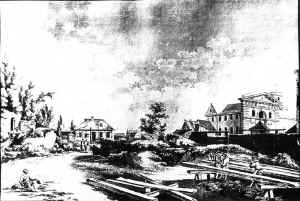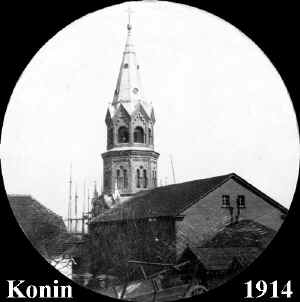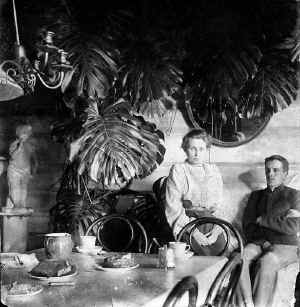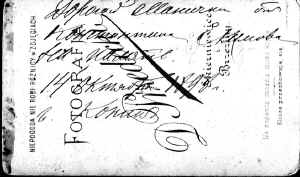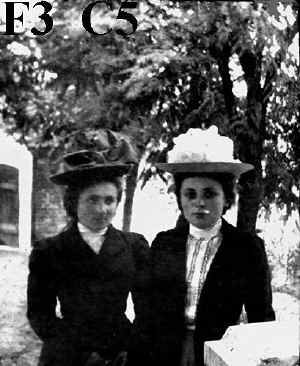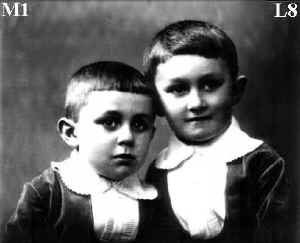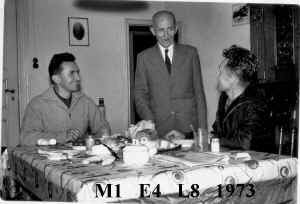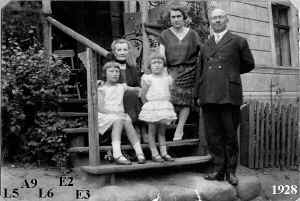FATE OF KIN HENKEL RELATED TO SANCT-PETERBOURG
As shows the Death record
of superintendent Karl Henkel, A8, Pastor of the Lutheran Church in Konin, Poland, the earliest known ancestor of this kin was Karl Henkel, owner of a factory, who was married to Friderike Altenberger. These Karl and Friderike Henkel belonged to the Reformed Evangelian Church and had 5 children: Karl (in all likelihood he died in his birth's year), Julius, Eduard, Friderik and Karl.The latter Karl Henkel (1841-1915), A8, was born on 22nd (i.e. 4th of the "old style") of October in Warsaw.
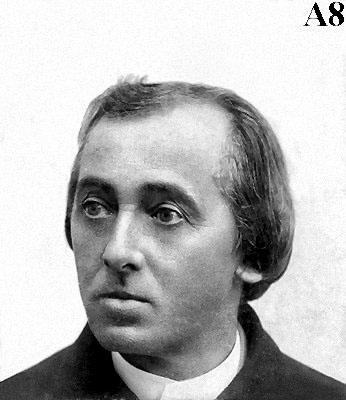
After having graduated from the University, he was appointed Vicar at the Reformed Evangelian Church in Warsaw in 1867 (ordination of the 16th of June), where he participated in consecrating of the new parish cemetery.
Cemetery and old church building (on the right) of the Reformed Evangelians.
In 1866-1880 a new building of the Reformed Evangelic church was erected in Warsaw, designed by Adolf Löwe (its tower repeating the tower of the church in Freiburg Breslau; today - 74, Solidarnosci, Warsaw) near the older smaller building (today - the Chamber Opera House, 76a, Solidarnosci, Warsaw).
After Pastor Johann Jacob Scholtz had died in Zychlin, the oldest Reformed Evangelic parish in Poland, not far from Konin, in 1886, Karl Henkel and his colleague August K.Diel from Warsaw were engaged as visiting pastors in Zychlin until the possessor of Zychlin, Adam Rafal Bronikowski, invited K.Henkel to occupy the vacant place in 1869. In 1879 K.Henkel finished a post-graduate course at the Derpt University and successfully defended his doctor theses gaining academic degree of the Doctor of Theology. In 1873 A.R.Bronikowski died and his widow Jadwiga became formal trustee of the Reformed Evangelic Church there. Unfortunately, she was a Catholic and at least paid no attention to the maintenance of the Church. At the same time part of the parishioners passed to newly established Evangelic Lutheran (Augsburg) parish, and the parish strongly diminished. Therefore, in 1883, after 14 years in Zychlin, K.Henkel decided to candidate as a pastor at a vacant place at the Evangelic Lutheran (Augsburg) Church in Konin.
Up to summer 1884 K.Henkel is not
engaged at any church at all. On the other hand, the Augsburg Lutheran
Consistory demanded his conversion into the Evangelic Augsburg confession. This
was done on 30 April, 1884. Then, on 27 July, 1884, Karl Henkel was nominated
rector of the Evangelic Lutheran Church in Konin. Nevertheless, the year 1885 is
erroneously indicated on the Epitaph
in his honour within the building of the Church.
There was a small Lutheran church in Konin
since 1854.
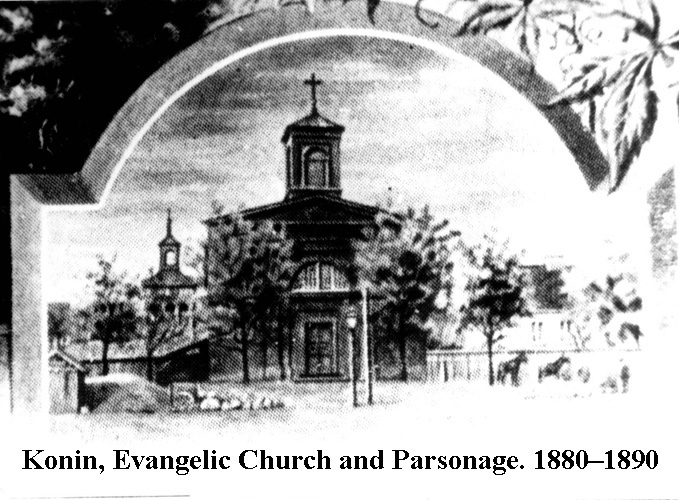
Lutheran church in Konin of 1854. The up today existing Parsonage is seen on the right beyond the fence.
During 14 years A8 was engaged in enlarging and rebuilding this church in Neo-Gothic style. The building was essentially lengthened with a porch, over which a huge bell tower was erected (according to Ed. Kneifel, the foundation of the tower was laid on 26 June 1901).
Glance from the garden at the parsonage and the church under reconstruction.
A gallery was raised on iron pillars and a vaulted ceiling crowned the interior.
Altar of the Lutheran church in Konin. On the right to the fore a pillar of the gallery is seen. To the right of the altar, after the pulpit, there is a honour epitaph of Pastor Karl Henkel on the wall (not seen).
The church, reconstructed by K.Henkel, and the parsonage in 1995.
K.Henkel was the first to introduce the divine service in Polish (beside German) in Konin. In the history of Konin he remained not only as builder of the new Lutheran Church but also as a famous teacher of the German and Greek languages in the pro-gymnasium there. He was a very popular and known personality, loved by his pupils, who named him Der-die-das. In letters of 1910 he is named superintendent. He died on 3 May, 1915, right away after finishing building of the Church. The reason of his death was the "throat's consumption", in fact, cancer. Although the main work of his life - the building of a new church in Konin - had been performed, his death might have been hastened by 2 circumstances more.The first circumstance was separation from 2 his daughters as well as from his beloved grandsons. The second one probably concerned the mystery of his son Alexander Henkel, E6. No data about Alexander have been ever obtained up to now neither from his sisters Maria, F3, and Martha, C5, who dwelled in Sanct-Peterbourg, nor from the descendants of his brother Karol, E4, and his sister Magdalene, E2, who remained in Poland. Even more, Maria Marks, L5, as well as Alina Sikorska, L6, daughters of E2, have unanimously asserted they had never heard about any "uncle Alexander" (both sisters were born after E2 had moved away from Konin to her husband Hugo Marks, E3, in 1917 or earlier). According to i7, already in his childhood (i7 spending summers in Konin), K.Henkel's folk avoided to speak about Alexander.
Of A8 there have been preserved many post-cards, written to his wife A9 from his journeys through Western Europe, his birthday-greeting postcard to his daughter F3, sent in Peterbourg, as well as his signatures in Church Registry Book. A plate with the Gospel words "Blessed are the pure in heart, for they shall see God" (in German), which once hung in the sacristi of the Lutheran church in Konin, is now kept by the family of Q3 in Kaunas. This plate was presented by A8 as a keepsake to his daughter Maria, F3, when she married in Sanct-Peterbourg Constantin.3 Klosse, F2.
A8 was married to Martha Splittstesser, A9, daughter of Karl Alexander Splittstesser.
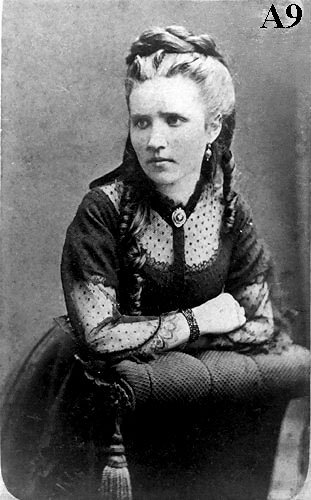
According to reminiscences of i7 (he was 11 years old at that time), his great-grandfather (with all probability, old father of A9) dwelled in a garret of the parsonage during the last years of life of A8. After the death of her husband A9 spent the remaining part of her life with her daughter Magdalene, E2. First she left Konin for Sierakow near Gostynin, to the house of her son-in-law Hugo Marx, E3, but in 1926 they moved to Nowe Miasto in the district of Lubawa after Hugo Marx had bought a house there, 1 Aleja (today - Narutowiczs Str.). A9 died in Nowe Miasto in 1942 and was buried on the Catholic Cemetery there with no cross or inscription till 2002 (her grand-daughter Maria Marks was buried in her grave in 2001). A letter of A9 written to her daughter F3 in Novgorod on 7 July, 1935, on the occasion of the latter's birthday has been preserved among papers of F3. E4, L8, M1, L6, L5 (see further) are mentioned in this letter.
A8 and A9 had 5 children: the daughters Maria Sophia (Dukhna, 1878-1962), F3, Martha Julia (Bibi, 1882-1965), C5, Magdalene (Nyunia, 1888-1980), E2, and the sons Karol (Bucynty, Bucio, 1885-1974), E4, and Alexander, E6.
Between 1892 and 1898 Constantin Ekimov (Koka), A4, a cornet of the 13th Kargopol dragoon regiment of the Russian 5th Cavalry Division, located in Poland on the German frontier, was introduced to the family of A8.

Photo of Koka of 1898, inscribed to Maria Henkel.
This was the youth, of A8's family as well as of the families of his neighbours Zaremba and Kasprowski, who made the acquaintance with young military servicemen in the small province town.
C4 dedicated his photo to Maria Henkel, F3, in 1898. Nevertheless he married Martha Henkel, C5, in 1900, and he took her for the first time to Sct.-Peterbourg and his family estate in Gorodishche, near Luga (railway station Utorgosh), in summer of the same year.
Of course, their marriage was Orthodox, but C5 did not change her confession.
Martha Henkel, C5, was born on 25 March, 1882. In 1897 she finished
maiden gymnasium school in Kalisz, but she studied at Pedagogic Classes
of the German and French Language at the 1st Maiden Gymnasium School in
Warsaw in 1897-1899.
Martha Henkel (on the right) with her school-mate after finishing gymnasium school in Kalisz. 1897.
On 5 June, 1899, she was presented diploma
of the teacher of the German language with the right to teach
German in all gymnasium schools of the Warsaw Educational District.
C5 having married C4, her further life ran by turns in Sct.-Peterbourg and in
Konin between 1900 and 1914.
Photo of Martha in the garden of parsonage, dedicated to her husband. 1910.
Martha nearby the photo of her father. The "first" flat on Bolshaya Konyushnnaya. 1914.
In 1901 C4 was appointed to a new post at Sct.-Peterbourg and was no more at service in Konin. In 1903 their first son Basily (Vasia), i7, was born. Daughter Nina was born in 1905 but soon died. Then followed 2 sons - Vladimir (Lyodia), H9, in 1906 and Constantin (Kotia), H7, in 1912. The summer 1914 was spent in Konin, but C4 was in Sct.-Peterbourg when the World War I break out in August. It was a panic at the railway and only with the help of military authorities and telegrams from Sct.-Peterbourg C5 succeeded to get on one of the overcrowded trains together with her children. They did not know that this was the end of normal life, of traditional Europe and of the 19th c. which as if had ended 13 years before. For 13 years the beautiful life delayed to withdraw and to make way for the age of horror and the genocide. C5 and and her sister Maria, F3, who had married in Sct.-Peterbourg earlier, in 1913, could not imagine that they would never see their home and their parents again.In Sct.-Peterbourg C5 finished medicine courses and became a sick-nurse at a military hospital in Tzarskoe Selo.
Engaged as a typist after 1917, C5 became the main bread-winner.
Lyodia and Kotia accompanying their mother home from nearby typewriting office. Ca. 1927.
God blessed their family: they, their children and grandchildren survived the second war. After the World War II C5 was a hall supervisor at the State Museum 'Hermitage'. The last Hall of her duty was really in the Hermitage: The Antique Gems Exhibition near the Golden Storage; for more years before she was on duty in the Winter Palace in Alexandre Hall, in which a Silver Exhibition was located.
Martha, dressed as a Hermitage worker, together with her son
Kotia and grandson Mika
on the terrace of Monplaisir in Peterhof. 7 06 1957.
Grandchildren of C5 made use of her
duties visiting Hermitage for free. After she had been pensioned off, till her
death in 1965 she still kept her special pass with which she and her
grandchildren could enter the museum without tickets. At those time her
colleagues at the control let them enter alone, even without her.
Martha's soul survives among all those exhibits of the Highest Beauty, as also
still survives in her flat on Bolshaya Konyushennaya str.
H7 recalled his mother C5 before 1917, when in a good mood, she used to say a
verse to any merry person of her homefolks: Kak
mednyj jakor na kolce, sijajet radost na lice ("Like a copper anchor on
a ring, joy is shining on your face"). Possibly this was said to her
either, when she in a cheerful mood came home from shopping. It seems, this was
typical of their last summers in Tzarskoe Selo before the Bolshevik revolt.
Martha Ekimov, C5, died in 1965 and was buried on Krasnenkoe
Cemetery beside her husband Constantin, C4, who had died in 1959. She
survived her sister Maria, F3, who died in 1962 (buried on the same cemetery,
although in a remote place, much farther toward the railway).
When cornet Constantin Ekimov, C4, dedicated his photo to Maria Sophia Henkel (1878-1962), F3, in Konin 1898, her sister Martha Julia, C5, studied in Warsaw.
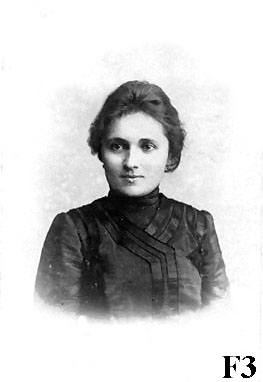
Maria Sophia Henkel
It is not excluded that this was a beginning of love between them, but coming of Martha, who shocked C4 with her beauty, destroyed this possible romance.
Koka's inscription of 14 10 1898 on his photo, dedicated to Maria.
2 things are known: F3 preserved this photo of C4 during all her life; she accompanied C5 in her trips to Sct.-Peterbourg later but finally married in Sct.-Peterbourg in 1913 too. In all following years she was devoted to the family of C4 and C5 and even became its voluntary servant after her husband's F2 death in 1939. What was the reason of such devotion and separation from the homeland and parents? No sign of anything similar could be seen from the side of the 3rd sister Magdalene, E2. The question arises, whether it was not but the hidden love of F3 to C4 which was no less strong than her love to her sister C5? Of course, Maria, F3 was the eldest sister, much nearer in age to Martha, C5 (only 4 years separated them), than to Magdalene, E2 (6 years). No doubt, F3 and C5 were close friends from the childhood.
Sisters Maria and Martha Henkel at the entrance stairs of the
parsonage
on the background of the Lutheran church. Konin,
ca. 1897.
On the other hand, F3 saw that C5 had left her behind in creating family and own
life, but no fascinating perspective was seen in provincial Konin, especially in
comparison with the brilliance of Sct.-Peterbourg. No doubt, F3 hoped to find
there her own luck, a person, maybe a handsome military officer, similar to C4.
A friend of the latter military officer Hasenkampf introduced her to his mate a
nobleman Constantin Klosse, F2, who was single but brought up 2 children,
Nicolas, M4, and Elisabeth, M3. F2 was a very attractive man
engaged as a violinist at the orchestra of the Maria Theatre. They
married in 1913. Soon the daughter, M3, died of a
grave inherited disease. The single baby of F3 and F2 died soon after the birth.
F2 possessed a house in Novgorod, on 14,
Slavnaya str. descending to the river Volkhov. F2's postcard of 21
March 1913 has preserved, written to F2 from Novgorod to Sanct-Peterbourg. The
arrangement of their house in Novgorod is described in this message.
The beginning "I have sent to you the first view with the town block on the right where my house is situated" sounds enigmatic. Possibly some previous postcard ("the first view") is spoken about, because this postcard depicts that place on the right bank of Volkhov, where Slavnaya str. is in the blocks on the left. If Constantin.3 Klosse, F2, is speaking about his father's house, why does he say "my house"? Although his father had been died long before, his house, if only existed, with all probability belonged to Therese von Klosse, F5, the widow of his son and Constantin's brother Paul, F4. If F2 is speaking about the house on Slavnaya str., why had he been forced to write on the balcony facing workers engaged in the reparation in all other rooms? Why could not he write in the wooden outhouse (by the way, the single known balcony was namely there)? If F2 has in mind the wooden outhouse, who dwelled then in the brick house? If this was his mother Laura, B4 (who was narrated to have lived in the wooden outhouse, see Klosse), the date of her death in 1907 must be revised. On the other hand, the brick house (if not given to Therese, F5, who in any case dwelled mostly on her constant place in Helsinki together with her children) was too huge for her and she should have sheltered her son there during reparations in the wooden outhouse. One must therefore conclude, that: 1) the brick house might have been either leased, or already sold at that time (in the latter instance it could not be nationalised from F2 after 1917); 2) B4 should have died before this. Then the best supposition is that F2 either decided to sell the brick house after her death, or to let it on lease. In both cases he should have moved to the wooden outhouse (this also explains the necessity of the reparation in the best way). The second striking feature of this card is that it points out to the address of the "first" flat, i.e. No 64, on 2, Bolshaya Konyushennaya str. in Sct.-Peterbourg. It seems that this is the single evidence for the number of this flat.
3 generations of Klosse in Novgorod: Constantin, his wife Maria, daughter-in-law Natalie with her son Kotia.
When spending summers there, F3 every year invited her sister C5 with husband C4 and children i7, H9, H7.
On 1 May, 1939, F2 died of pneumonia in Sct.-Peterbourg, 54, Officerskaya str., flat 27 (this was their last flat rented before 1917).
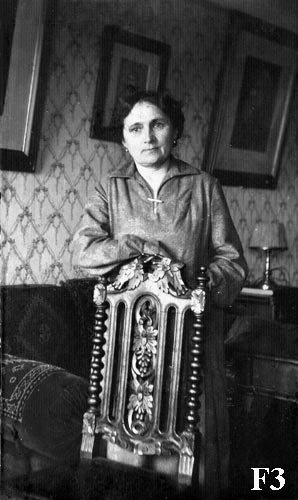
Maria Klosse née Henkel in her flat on Officerskaya str.
In following years spending summers in Novgorod continued but without F2. In June 1941 F3 was in Novgorod with Q8 and R1, the small children of H9 and i1, the latter being still on duty at the Maria Theatre.
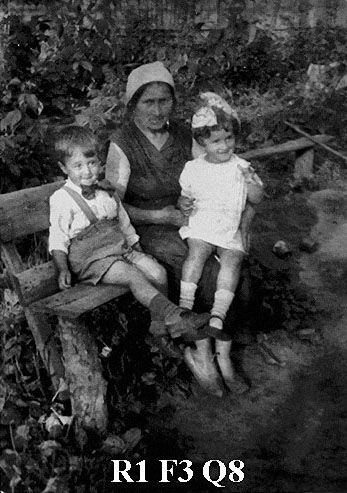
Maria Klosse with grandchildren of her sister Yusha and Ina in Novgorod.
The war broke out on 22 June, a panic movement of thousands of people, especially
those on vacation, began in all directions. Every hour was important, the trains
were overcrowded. If F3 had been late to bring children to Sct.-Peterbourg as
soon as possible, their evacuation together with their relatives would have been
impossible, the children would have perished in the blockade or in bombed
Novgorod. F3 did her best and saved them. This was her heroic deed which ensured
further normal life of at least 6 people. Soon they all together with C4 and C5
were evacuated to Perm.
All was destroyed in Novgorod during the war, the house
was burnt down.
Nobody left Sct.-Peterbourg during summer vacations in the
first post-war years, only Q8 and R1 were sent to children pioneer camps.
F3, who dwelled in a smaller room on 54, Officerskaya Str. (the larger room given up to H7 and H8), went to her sister's home on 2, Konyushennaya Str. every morning as if to job, coming home late in the evening. Constantly she turned into a home worker. She even let the sister of her flat's neighbour with 2 children to live together with her in her own room for free.
From the right: Maria Klosse, her lodgers Tamara and Varvara, sister of Varvara on Officerskaya.
This sister, Ekaterina, was ethnic Russian mother-in-law of F2's colleague and neighbour oboist Wadim Sauerländer. Dark people from some Russian village, the lodgers burnt Klosse's family chairs, which needed reparation, as firewood.

Maria Klosse in 1950 taking a walk with her neighbour, a grandson of her sister.
It seems, this was on 13 April 1960 when a car stroke F3 down breaking her arm. She lost consciousness, but when she came to herself in a hospital, her mind was touched, she lost her orientation. Intensive process of sclerosis began. Being unable to think normally, she sat in her room all days long reading newspapers and speaking with politicians depicted there. She was indignant at American imperialism and used to talk to N.Khrushchov dooming D.Eisenhower. Seing inevitable end, H7 and H8 asked authorities to join her room to their neighbouring "dwelling space", but the answer was negative. This meant that the Soviet power condemned H7, H8 and their young son Q3 to spend all their life in one common room of 28 m2. Then the lodgers were finally got rid of but H7, H8, Q3 and F3 organised the exchange of the both rooms on Officerskaya str. for one large room of 40 m2 on 21, 8th Ismail Rota (Krasnoarmeiskaya str.) in 1960. This was no more historical Old Sanct-Peterbourg, but old proletarian and military-barracks outskirts between Fontanka and Obvodny canal, not far from Warsaw and Baltic railway stations. They got to a huge communal hostel of 10 rooms on the 1st storey, the flat having belonged to the possessor of the house before 1917, but their room having been his salon. There was an artistic hearth-like stove, 2 big windows, a door to the balcony in the centre between them, as well as ceiling with marvellous stucco mouldings in this room.
Having moved to the 8th Ismail Rota, Maria Klosse reading a newspaper. 1960.
F3 had own corner near the
right window behind big furniture. Every evening she took her bed-clothes and
went to the common corridor in search for her room. She died in fully
unconscious state, although moaning of pain (possibly she had an apoplexy on her
last day), on 30 January 1962.
[Soon
her sister Martha, C5, died on Bolshaya Konyushennaya in 1965.
3 years later, in 1968, H8 died on the 8th Ismail Rota. Q3 having fled to
Lithuania in 1970, his father H7 remained alone in the room with marvellous
ceiling until he retired and moved to his son in 1984]
At the time F3 (1962) and C5 (1965) died in Sct.-Peterbourg, their brother Karol (died in 1974), E4, and sister Magdalene (died in 1980), E2, were still alive in Poland, but nobody knew this. Ethnic Russian Soviet Power did not treat common citizens as people and forbade them to have relatives abroad, even in the "socialist" countries.
The World War I and the death of A8 dramatically changed the life of his nearest relatives who had remained in Konin before 1914. First and foremost they had to sell their family property in order to move to any other place from the parish house.
Karol Henkel (Bucynty, Bucio, 1885-1974), E4, who had studied law at the university of Sct.-Peterbourg, was just beginning his career. After finishing the university he was engaged at the Russian Ministry for Foreign Affairs (perhaps with the help of Eugene Visconti - cf. Visconti) for several years before 1917.
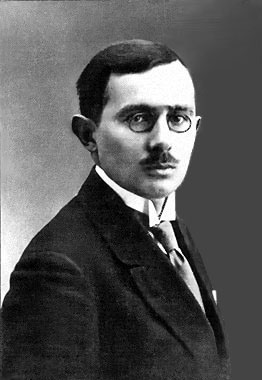
Having come in already independent motherland from the SSSR in 1921, and reported at the Ministry of Foreign Affairs of the Republic of Poland, M1 continued his career successfully in the Eastern regions (Grajewo, Bialystok, Grodno). For several years he was Mayor of Grodno. He met his future wife Bronislawa (1900-1948), E5, in Grajewo. E5 originated from a known Catholic family of Chiczynski.
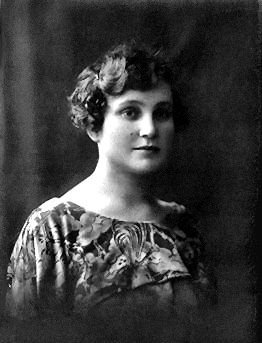
The Catholic bishop in Lomża did not permit her to marry a Lutheran, therefore their marriage took place at Lomża Lutheran Church, the wife retaining her Catholic confession. There was only Bronislawa's grandfather who participated in the wedding ceremony from her side.
When Poland was divided between Germany and U.S.S.R. in accordance with the pact of Ribbentrop-Molotov, E4 and his family appeared in the Soviet zone. First he was arrested, but his family was sent to Siberia. E4 was liberated by German troops in 1941. During the war he was engaged as a lawyer at Bialystok. The Red Army nearing, he fled to Nowe Miasto and sheltered at his sister Magdalene Marks, E2. A Soviet air force staff was located at her house. This helped E4 to become an interpreter from Russian into Polish and vice versa. Due to this he was admitted to communist administration of those Northern Polish areas which had been included into the German Reich earlier. In this way he appeared in Stettin where his wife E5 also came after she had returned from Siberia to Bialystok in 1946. Fully exhausted, she died in Stettin in 1948. After having retired, E4 lived at his youngest son Jerzy Henkel in Warsaw but died there in 1974.E4 and E5 had 2 sons: Ryszard (1923-2009), L8, and Jerzy (born in 1924), M1.
Jerzy and Ryszard Henkel in Bialystok. 1928.
After the division of Poland between the Soviets and the Nazis in 1939, both brothers appeared in deportation in Altai. When the Polish Army of General Anders was formed on the territory of the U.S.S.R. due to the treaty between Molotov and Sikorski, Head of the Polish Government in exile, Ryszard, L8 succeeded to reach Barnaul and escaped to the West in this army. Jerzy, M1 wanted to follow him, but the diplomatic relations between Sikorski and Moscow were ruptured after the murder of the Polish officers in Khatyn. All Polish youths, who awaited a possibility to join the Army of General Anders, were arrested and forced to take Soviet citizenship. After that M1 became a Soviet military serviceman and fought against the Germans within communist Wojsko Polskie. After the war M1 first went to his father in Szczecin (Stettin), but he went to Warsaw together with his father later. His brother L8, who was in the West in the Army of General Anders, made use of the proposition to remain in the West after the war and went to the U.S.A. where he was engaged as an engineer at one of the plants in Chicago for many years.
Ryszard Henkel (on the right) as a guest at his father
(standing in the middle) in Szczecin.
Jerzy Henkel is sitting on the left.
On the wall Bronislawa's portrait is seen. 1973.
In Chicago he married Janina
Sinkowska, a Latvian Pole (died at the end of 1990s, her last will was that
her ashes would be strewn over Latvia). Being retired he dwelled in solitude after Jadwiga's death. Sometimes he was visited by his children and his brother with
wife. He died at a rest home on June 1, 2009. His Americanised children Jerry, Suzan, Bob and Mark
are dispersed over the U.S.A.
As for his brother Jerzy, M1, he is a
pensioner dwelling in Warsaw. His wife Barbara, M2, née Gwarecka, a
known journalist of the monthly "Pani", died on June 1, 2010 (buried in Warsaw beside her father-in-law). They have had
no children.
Magdalene (Nyunia, 1888-1980), E2, married Hugo Marx (1875-1947), E3, a businessman, in 1917, and left Konin to Sierakow near Gostynin.
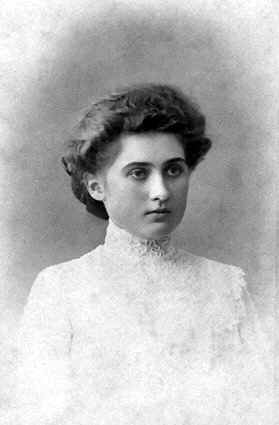
Magdalene being photographed in Sanct-Peterbourg.
Hugo Marx.
In 1925 E3 purchased a big house in the outskirts of Nowe
Miasto in the district of Lubawa, 1,
Narutowicz's Alley.
Nowe Miasto (up to 1918 German Neumark) is located on historical Old
Prussian territory, occupied by the German Knights in the 13th c. and
Germanised in following centures. After 1918 this strip of Thorn/ Torun,
Graudenz/ Grudziąc and Kulm/ Chelmno land (so called Kulmerland) came
from Germany to Poland.
A9 introduced strict Lutheran order at home: at fixed time a bell called the inhabitants to breakfast, lunch, second lunch and supper in the salon. If somebody was late a few minutes, this was a reprehensible event. A9 occupied a room next to the salon. Usually she sat in her room in her vehicle armchair and was busy with the crochet or reading. Jerzy Henkel, M1 recalls how he was a guest there together with his father Karol, E4, and how A9 intently looked at him through her lorgnette as if examining whether that small boy really was her grandson and corresponded to her high-level traditions. E4 was "a poor relative" then. At the lunch table he whispered to his son not to ask for a second cake, far from it!
A9 died in 1942, when the German occupant military servicemen were settled in that house. She outlived her husband at 27 years.
At that time E2 and E3 brought up 2 daughters, Maria (born in 1918), L5, and Alina (born in 1924), L6.
Marysia, Martha Henkel, Alusia, Magdalene and Hugo Marks (Marx) in Nowe Miasto.
When the Russian army came, both
had to skulk on the loft in order not to be raped. A Soviet military officer
settled in their flat and daily carouse took place. Once the girls were found
and only a drastic and bold intervention of their uncle E4 saved them.
After the war L6 went to her uncle Karol, E4, in Szczecin after her cousin M1,
but she married Tadeusz Sikorski, L7, there. They have had 3 children: Zdzislaw
(1953), Beata (1955) and Ryszarda (1956). The latter became a
physician but fell ill and died young in 1991, in the same hospital where she
had been engaged.
In Nowe Miasto Magdalene Marks, E2, was still living together with her daughter Maria Marks, L5. They dwelled in 2 rooms left to them by communist authorities who had nationalised the whole building. These 2 rooms, an antechamber and a kitchen was a small part which remained of their former flat on the ground storey. After Magdalene's E2 death in 1980, Maria, L5, remained there alone. Every Christmas she visited her sister Alina, L6, in Szczecin. Growing weak, she invited to live together a widower Konstanty, a friend of her youth, whose marriage once had destroyed her life. In her last years the whole house was given back to her and she could rent it again thus essentially improving her life. Unfortunately, this came too late, the life was finished. The single profit was that she could hire for herself a nurse Sabina Tessmer from the neighbourhood. It was the house of Sabina, where she died on 10 June 2001. Konstanty died next year in his house in Ilawa. Today the house on Narutowicz's Alley belongs to Alina Sikorska, née Marks, L6, and her family.
The kin of Henkel
is related to that of Ekimov
through the marriage of C5 and C4.
The kin of Henkel
is related to that of Klosse
through the marriage of F3 and F2.
